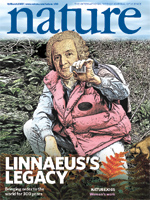 A dozen articles in current issue of Nature examine the legacy of Carl Linnaeus, born 300 years ago this May. The wonderful cover illustration shows Carl Linnaeus as a modern field biologist in blue jeans and down vest, holding up a DNA barcode. I am particularly struck by Charles Godfray’s “Linnaeus in the information age,” a wide-ranging, thoughtful, visionary and practical look at how taxonomy might evolve so as to provide the widest benefit to society. His near-term wish list includes “a comprehensive web-based taxonomic and identification resource (morphology plus DNA barcodes) for the world’s macrolepidoptera”, which “would be a wonderful lever for bringing new resources into the field.” A central theme echoed in many of the pieces is the need for taxonomists to join together and create “big science” projects that benefit the many end-users of taxonomic knowledge.
A dozen articles in current issue of Nature examine the legacy of Carl Linnaeus, born 300 years ago this May. The wonderful cover illustration shows Carl Linnaeus as a modern field biologist in blue jeans and down vest, holding up a DNA barcode. I am particularly struck by Charles Godfray’s “Linnaeus in the information age,” a wide-ranging, thoughtful, visionary and practical look at how taxonomy might evolve so as to provide the widest benefit to society. His near-term wish list includes “a comprehensive web-based taxonomic and identification resource (morphology plus DNA barcodes) for the world’s macrolepidoptera”, which “would be a wonderful lever for bringing new resources into the field.” A central theme echoed in many of the pieces is the need for taxonomists to join together and create “big science” projects that benefit the many end-users of taxonomic knowledge.
News
Tommy Gold’s url
We were troubled to find that Tommy Gold’s pages have disappeared from the Cornell University website but delighted to find they have been saved by the Wayback Machine of the Internet Archive.
The last time it was archived in the Wayback Machine seems to be June 2005, and the page has material through October 2000. We may be missing material that was entered between 2000 and 2004, but this is much better than disappearance!
June 2005 https://web.archive.org/web/20050616080751/https://www.people.cornell.edu:80/pages/tg21/
Big habitat projects flourish
Almost exactly 10 years ago, Jesse and Bill Nierenberg organized the first workshop at Scripps Oceanographic Institution that led to the Census of Marine Life, which earned the cover of Science News magazine 17 February. A little more than five years ago, in February 2002, Jesse and Paul Hebert met at a Census of Marine Life workshop in White Point, Nova Scotia, and joined forces to initiate the Barcode of Life initiative, which earned the cover of Canadian Geographic this month. We happily celebrate the anniversaries of these wonderful projects and thank everyone participating.
E O Wilson’s Encyclopedia of Life
For the past year Jesse has chaired a small group to help realize the vision of an on-line Encyclopedia of Life with a web page for every species proposed by Edward O. Wilson, Dan Janzen, and others. Ed made the EOL his wish at the TED conference in Monterey CA on 8 March.
Wood Products magazine covers Forest Transition
Wood and Wood Products magazine published an interview view with Jesse about the forest transition in its February 2007 issue.
Indomalayan All Birds converge in Singapore

A flock of 22 scientists converged on National University of Singapore on March 8-9, 2007 for a 2-day Indomalayan Organizational Meeting for All Birds Barcoding Initiative (ABBI), including representatives from India, Indonesia, Malaysia, Philippines, Singapore, Sri Lanka, Thailand, and individuals from European and North American museums with active collaborative research programs in this region.
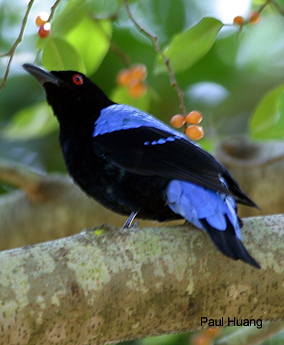 The Indomalayan biogeographic region spans a vast area of tropical biodiversity and includes inumerable islands with high numbers of endemic species. A large scale genetic survey with DNA barcoding is likely to help lead to dramatic increases in species counts in particular and better understanding of biodiversity in general. Additional collecting may be particuarly important in this region, as it is at present the least well-represented in frozen tissue collections. There was strong enthusiasm among regional participants, and recognition the initiative has public appeal and the potential to engage new sources governmental support.
The Indomalayan biogeographic region spans a vast area of tropical biodiversity and includes inumerable islands with high numbers of endemic species. A large scale genetic survey with DNA barcoding is likely to help lead to dramatic increases in species counts in particular and better understanding of biodiversity in general. Additional collecting may be particuarly important in this region, as it is at present the least well-represented in frozen tissue collections. There was strong enthusiasm among regional participants, and recognition the initiative has public appeal and the potential to engage new sources governmental support.
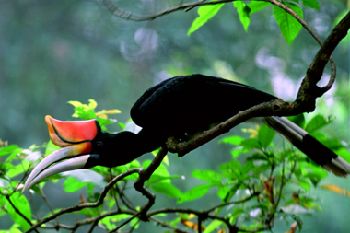 I look forward to organizational and scientific progress in this exciting region.
I look forward to organizational and scientific progress in this exciting region.
DNA barcodes for North American birds paper on-line
We post “Comprehensive DNA barcode coverage of North American birds” recently published in Molecular Ecology Notes. PHE’s Mark Stoeckle co-authored the paper along with the now almost-classic 2004 paper “Identification of Birds through DNA Barcodes.” As Mark likes to say, Barcoding takes flight.
Industrial Ecology of Cadmium
Progress in Industrial Ecology published the Ausubel-Wernick-Barrett-Waggoner paper Industrial Ecology for Leverage to Let Loose Less Cadmium . We thank Peter Elias, who helped us start work on cadmium back in the 1990s. The paper exemplifies a kind of analysis we recommended in our 1997 report Industrial Ecology: Some Directions for Research. The growth of industrial ecology as evidenced by the development of the Journal of Industrial Ecology, Progress in Industrial Ecology, and the International Society for Industrial Ecology is gratifying. And, for those worried about cadmium, remember to think zinc.
Horizontal genomics with bats and birds
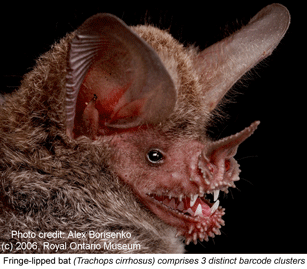 Two papers in early online Mol Ecol Notes report large scale COI surveys of tropical bats and North American birds. In the first paper, Clare et al examined 840 specimens representing 87 (72%) of 121 known bat species in Guyana, each derived from vouchered specimens held at Royal Ontario Museum, including multiple individuals (range 2-74) from 73 (84%) of species. 81 of 87 species had distinct COI barcodes with average intraspecific variation of 0.6%. In the remaining 6 species, 15 distinct mitochondrial lineages were found which likely represent overlooked cryptic species.
Two papers in early online Mol Ecol Notes report large scale COI surveys of tropical bats and North American birds. In the first paper, Clare et al examined 840 specimens representing 87 (72%) of 121 known bat species in Guyana, each derived from vouchered specimens held at Royal Ontario Museum, including multiple individuals (range 2-74) from 73 (84%) of species. 81 of 87 species had distinct COI barcodes with average intraspecific variation of 0.6%. In the remaining 6 species, 15 distinct mitochondrial lineages were found which likely represent overlooked cryptic species.
As most bats are small brown animals that fly around at night emitting noises that humans cannot hear, it is not surprising that some have been overlooked, and it seems probable many new species will be found lurking in museum drawers. Even in relatively bat-poor temperate regions there may be hidden diversity. It was not until 1997 that Europe’s most abundant and best studied bat, the Pipistrelle (Pipistrellus pipistrellus, Schreber 1774) was suggested to be 2 species through DNA analysis, a hypothesis confirmed by biological covariants and official species designation in 1999.
In the second paper, Kerr et al (I am a co-author) report a continental-scale survey of mtCOI sequences in North American birds, including 2590 individuals from 643 species, representing 93% of the breeding avifauna of Canada and the United States. 94% of species had distinct barcodes, and in the remaining 6%, barcode clusters corresponded to small sets of closely-related species, most of which hybridize regularly. Fifteen (2%) of currently-recognized species were comprised of two distinct barcode clusters, many of which may represent cryptic species.
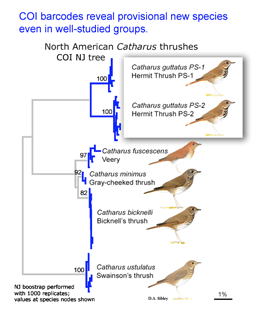 Birds being conspicuous, vocal, diurnal animals it is surprising that there are what appear to be overlooked species, even in an intensively-studied temperate region with relatively few species. Of course barcode clusters are not proof of species status, but to my knowledge all such divergent lineages either correspond to recognized species, or have subsequently been found to show biological covariants and have ultimately been granted species status.
Birds being conspicuous, vocal, diurnal animals it is surprising that there are what appear to be overlooked species, even in an intensively-studied temperate region with relatively few species. Of course barcode clusters are not proof of species status, but to my knowledge all such divergent lineages either correspond to recognized species, or have subsequently been found to show biological covariants and have ultimately been granted species status.
Sequencing of large tissue collections housed in museums can be done relatively rapidly and inexpensively. It is a challenge on how to report results in a way that communicates the genetic findings in a timely fashion without trampling on the careful procedures designed to maintain order in taxonomy.
By using tissues derived from vouchered museum specimens, these barcoding studies lay the groundwork for subsequent taxonomic study. By analyzing a standardized region, DNA barcoding studies can be stitched together to create a large-scale map of biodiversity, a horizontal genomics approach mapping leaves on the tree of life.
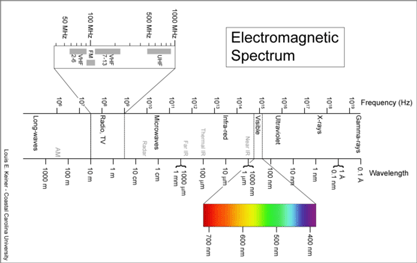 I see the “barcode map of genetic diversity” as analogous to an astronomical sky map that uses just a slice of the electromagnetic spectrum. It does not contain all the information necessary to understand the universe, but by focusing on one part of the spectrum it enables results from various studies to be seamlessly combined and allows both large and small scale comparisions.
I see the “barcode map of genetic diversity” as analogous to an astronomical sky map that uses just a slice of the electromagnetic spectrum. It does not contain all the information necessary to understand the universe, but by focusing on one part of the spectrum it enables results from various studies to be seamlessly combined and allows both large and small scale comparisions.
DNA barcodes for almost all North American birds published
Our paper establishing DNA barcodes for almost all (94%) of North American birds appears, together with a paper on barcodes for bats as well as a methodological paper, in Molecular Ecology Notes. For a copy of the paper as well as images and other information, visit
https://www.barcodeoflife.org/barcode/batsbirds/